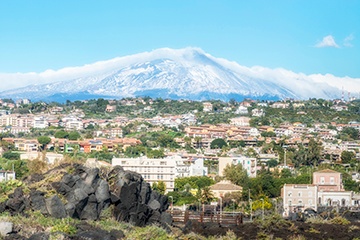 Scientists from the University of Queensland and Trinity College Dublin studied the most active volcano in Europe, Sicily’s Mount Etna, to better understand its eruption history. Currently, there is no way to predict volcanic eruptions, but tiny crystals formed prior to an eruption, may provide valuable evidence of the process that leads up to and the timing of volcanic activity, information that may help in building an early warning system.
Scientists from the University of Queensland and Trinity College Dublin studied the most active volcano in Europe, Sicily’s Mount Etna, to better understand its eruption history. Currently, there is no way to predict volcanic eruptions, but tiny crystals formed prior to an eruption, may provide valuable evidence of the process that leads up to and the timing of volcanic activity, information that may help in building an early warning system.
The crystals are carried to the surface of the earth along with the magma as it surges upward. They grow and change in composition before they erupt from the volcano. According to the scientists, the crystals have a memory similar to the rings that form as trees grow.
Scientists employed laser technology from Teledyne CETAC to “map trace elemental distributions within clinopyroxene crystals from recent (1974-2014) eruptions.”
From the published study at Nature.com, “Laser ablation-inductively coupled plasma mass spectrometry data were obtained in 2015 and 2016 at the Geochemistry Laboratories of Trinity College Dublin. We used two separate instruments, both equipped with a 193 nm Excimer UV ArF laser with a Helex 2-volume ablation cell, and a quadruple ICPMS mass spectrometer. The first unit is a Teledyne Photon Machines G2 laser coupled to a Thermo Instruments iCapQs ICPMS. The second is a Teledyne Photon Machines Excite coupled to an Agilent 7900. In both cases, ablation was performed in ultra-pure He to which Ar make-up gas with a trace amount of N2 was added for efficient transport and to aid ionization.”
Additional details about the laser parameters, gas flows and mass spectrometer operation are available online at Nature.com.
The laser ablation-ICP data indicated, “growth layers record the changes a volcano goes through that signals it’s getting ready to blow. At Mount Etna, the arrival of fresh magma approximately six miles below the surface proved a reliable indicator that an eruption would come within just two weeks.”
A geologist from the University of Wisconsin told Newsweek, “One exciting take-away from this report is that researchers can use this method to study historical eruptions as well as contemporary volcanic activity to provide a history of volcanic eruptions in order to better understand the controls on those eruptions.”
The scientists plan to use a similar approach to studying other volcanoes around the world.
For more information on Teledyne CETAC and the Excimer UV ArF laser with a Helex 2-volume ablation cell, visit our website at www.teledynecetac.com or click the button below


